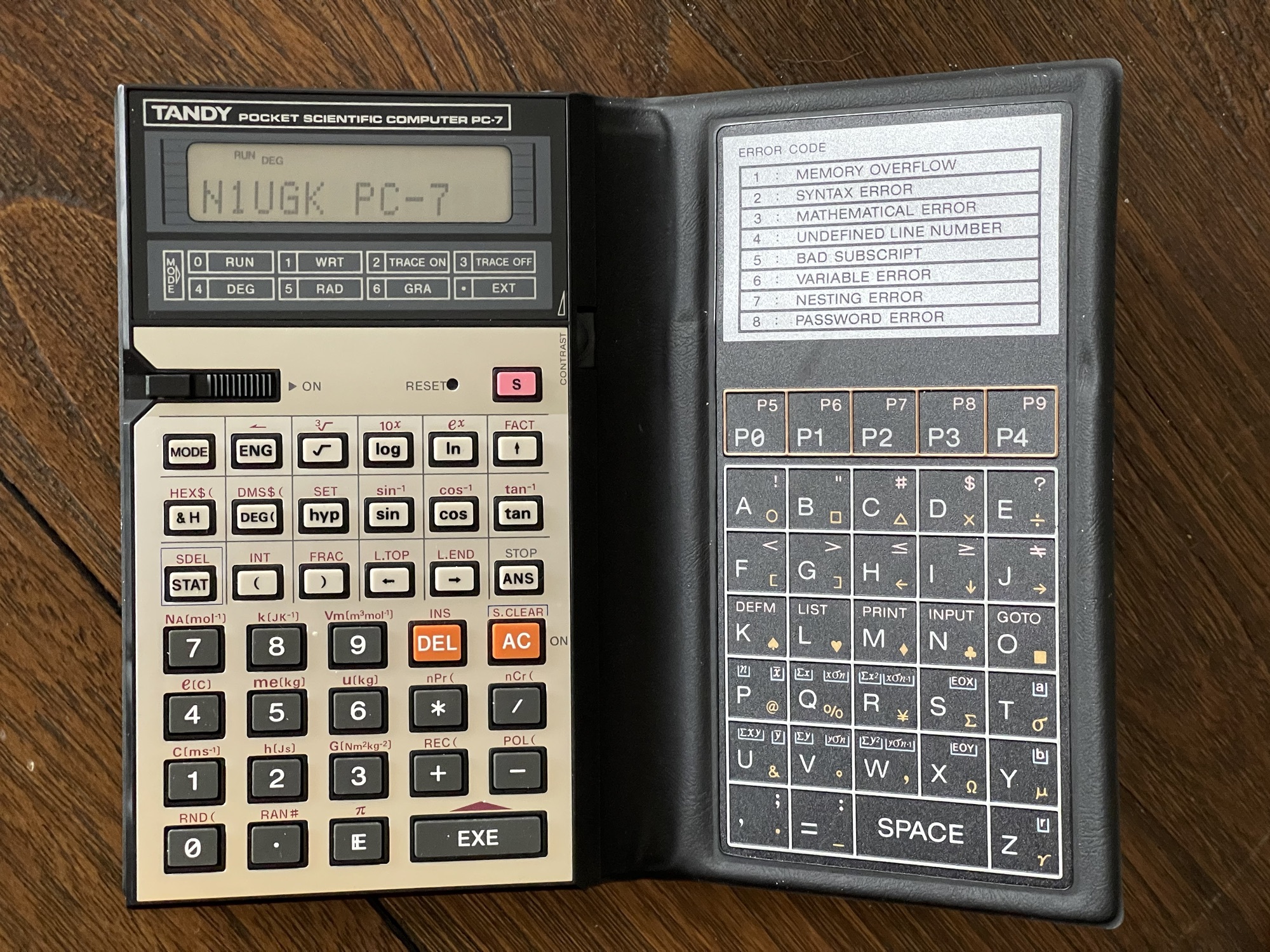
Tandy PC-7 Pocket Computer
The PC-7 pocket computer was the first pocket computer I owned. In fact, it was the first computer I had at home. At the time I had the PC-7, my experience with computers was limited to what we had been exposed to in school, which were Apple computers.
This was the first “calculator” I had ever used which had an EXE button instead of the typical equals “=“ key. It was also the first I had used which had a contrast dial and a physical power switch instead of an “on” button.
I was familiar with BASIC and when I got the PC-7, I spent a lot of time writing programs, most of them involving random number based games and screen effects. This was the first time I saw bitmap letters and symbols on a calculator screen instead of the standard segmented display of typical calculators.
Of course the screen size was only 12 characters and was not pixel addressable like the Apple II machines were, and the PC-7 had no buzzer or sound capability like the PC-2 had.
In fact, this is the only pocket computer Radio Shack sold which had absolutely no ability for memory expansion nor peripherals. I had wanted the PC-8, but was unable to get one, as they were always out of stock.
The PC-7 had quite a few icon characters allowing for interesting games to be programmed. It even had a full set of poker/playing card characters that could be used.
Radio Shack Pocket Computer Releases
The PC-7 was introduced in catalog year 1987 and sold through catalog year 1989. The PC-6 was released the same year (for significantly more money) but continued being sold through 1992, the longest running model in the entire line.

Radio Shack continued with the Casio line when they released the PC-7, making this the fourth and last Casio model they sold.


The program space was segmented into 10 areas. These areas are P0 through P9. This differs from the Sharp models where the program space was not segmented at all. If you wanted to store more than one program, you had to do so by getting creative with the line numbers (keeping programs segmented). With the Casio models, the segmented program areas allow for up to 10 programs, each in their own space.
The PC-7 was a rebadged Casio FX-5200P, which had only 512 bytes of memory.
The PC-7 had the 1 KB memory expansion built in, giving it 1,568 bytes of program memory after a reset. I remember entering programs and watching that memory remaining display counting down after each line entered. The rebadged Casio models all had a dedicated memory remaining display. This was always visible, unlike the rebadged Sharp models.

I remember when I had to change the batteries back then, there was a slot or cut out where the memory expansion would be placed. I remember checking the Radio Shack catalogs hoping to find a memory expansion or a printer interface option, but none were available for this model.

In fact, there was a plastic sheet which covered up the terminals on the PCB which would make contact with the expansion pack for the Tandy version.
The PC-4 which had also been released with such a small amount of program memory built in (similar to the Casio version of the PC-7). However, the PC-4 did have a memory expansion module available and it also had peripherals, a cassette interface and printer as available options.
Unique Design
The PC-7 had a folding design, with the alpha keys on the flexible membrane side. Back then, I did not have any issues with this unfortunate design, but over time, the flexible membrane that connects to the main PCB wears. Even mine shows signs of keys sometimes not working on the first try.
This design was quite different from all prior models because of this form factor. It is similar to regular calculators with its folding cover.
It is interesting that Radio Shack released both the PC-6 and PC-7 foldable models in the same catalog year.
The keys on the body of the calculator were rubber, similar to the PC-5 and PC-6. The Casio models did not use the more durable plastic key designs like the earlier Sharp models that Radio Shack sold.

The PC-7 had to be used on a flat surface – holding it was a bit unwieldy. Folding the keyboard membrane all the way back around the calculator was a bad idea.

When comparing the PC-7 and PC-8, the size is the same. The PC-8 has a hard cover, while the PC-7 might not survive long when kept in a pocket. The PC-8 on the other hand would easily survive.
Further, the PC-8 managed to pack all numeric and alpha keys on the face (like almost all other pocket computers of the era) without a folding design.
Final Thoughts
Although this is my least favourite of the Radio Shack line of pocket computers, it is the most nostalgic for me, as it is the only one I actually owned back when these were sold.
With no peripheral options, the folding design, limited memory, the PC-7 was unique across the line of pocket computers Radio Shack sold.

